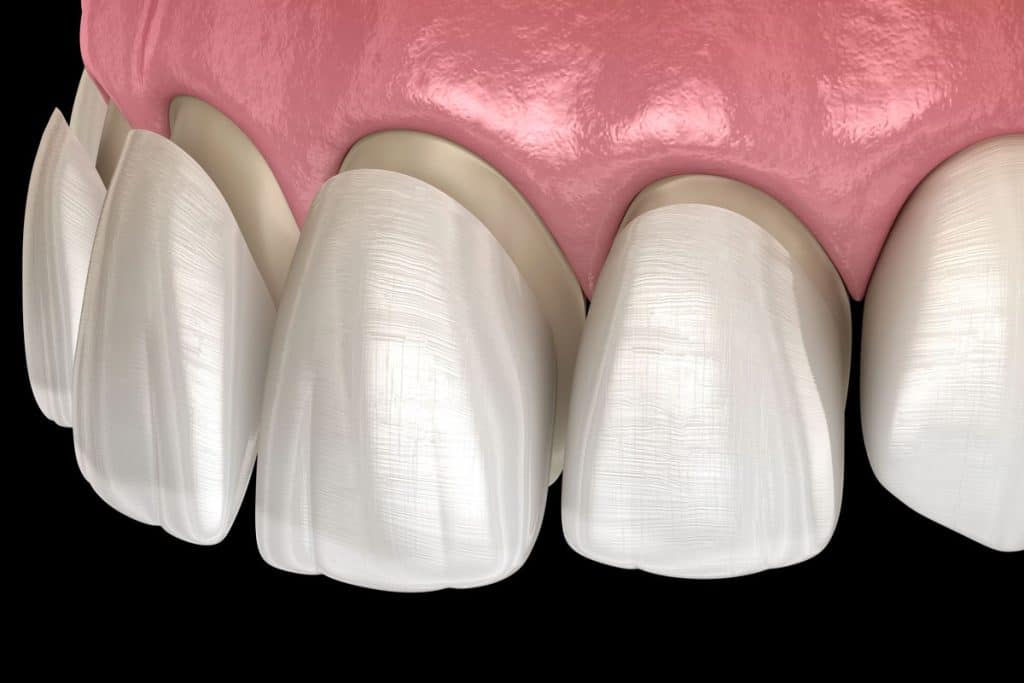Dental veneers are tooth-colored shells that adhere to the front of teeth. Two of the most common material types are composite and porcelain, each with pros and cons. Composite veneers and porcelain (or ceramic) veneers differ in quality, cost, aesthetics, and application process.
Patients should be aware of the costs and effectiveness of each treatment and have realistic expectations of what composite vs porcelain veneers can do for their appearance and oral health.
Composite vs Porcelain Veneers
Composite and porcelain veneers are crafted to restore a single tooth piece or the entire tooth arch. Both veneer procedures aim to achieve the same goal, but the materials, methods, and outcomes can vary.
Cost
Porcelain veneers are more expensive due to higher quality materials and craftsmanship required. Porcelain or ceramic veneers cost between $1,000 and $2,500 per tooth. Composite veneers are a more cost-effective choice, priced between $250 and $1,5000 per tooth. Dental veneers are typically not covered by insurance since they’re considered elective for cosmetic purposes.
Aesthetics
Porcelain veneers are considered a better aesthetic choice and are behind the famed, symmetrical “Hollywood smile.” This look isn’t for everyone, though. Some patients consider these veneers to be excessively large and unnaturally white. If you’re in that camp, fear not. Dental veneers made from porcelain can be any shade and tone you want, thanks to a custom color-matching process.
Porcelain material also mimics the light-reflecting properties of natural teeth, allowing them to achieve a more realistic, translucent, and natural appearance than composite veneers. Composite veneers are prone to staining, making them look duller over time. The appearance and longevity of both largely depend on the dentist’s skill.
Veneer Material
Composite veneers, also called direct veneers, are made from composite resin. Composite resin is a moldable synthetic material made of acrylic and glass particles. This dental composite results in a putty-like consistency that can be molded and applied directly to the tooth. On the other hand, porcelain veneers are made from wafer-thin pieces of dental ceramic, specifically feldspathic ceramic or lithium disilicate.

Process
The porcelain veneer process can take several weeks, whereas composite veneers can be applied in one appointment. This shortened process is because composite materials require less laboratory work and can be molded and manipulated chairside.
Pros & Cons of Composite vs Porcelain Veneers
When deciding between composite and porcelain veneers, it’s important to understand the pros and cons of each option to make an informed choice.
Pros of Composite Veneers
- Procedure reversibility as composite veneers involve minimal or no enamel removal.
- More affordable than porcelain veneers. Composite veneers cost less because the resin-based material used is less expensive and doesn’t require precision or specialized techniques to apply.
- Faster and less invasive application process. Composite veneers can be applied in a single dental appointment.
Cons of Composite Veneers
- Shorter lifespan. Composite veneers last 5 to 7 years, on average.
- Higher potential of staining due to porous material, increasing the likelihood of discoloration or a dull appearance (especially for regular consumers of tobacco, red wine, tea, or coffee).
Pros of Porcelain Veneers
- Built to last. Porcelain veneers’ glass-like composition can withstand extreme temperatures, harsh chemicals, and fractures.
- Bright and white shades are baked into the non-porous porcelain material at high temperatures, ensuring consistent and vibrant color for longer.
- Stain resistant. Once the veneers are placed, porcelain material can better withstand discoloration caused by coffee, tea, and cigarettes.
Cons of Porcelain Veneers
- Irreversibility. Natural tooth enamel is removed to prep the tooth for the porcelain veneer. Porcelain veneers are a permanent choice, as tooth enamel cannot grow back.
- Time-consuming process that spans multiple dentist visits over several weeks. Back-and-forth communication can result in further setbacks or delays.

What Issues Can Dental Veneers Fix?
Dental veneers enhance or correct teeth that function properly on issues that aren’t deemed medically necessary. Porcelain and composite veneers can fix various cosmetic issues caused by aging, lifestyle choices, gum recession, genetics, or natural teeth shifting. These dental issues may include:
- Uneven tooth size
- Crooked, gapped, or misaligned teeth
- Worn down molars from grinding
- Stained or yellowed teeth
Dental veneers can bridge tooth gaps, elongate or widen tooth shape, correct color, size, or symmetry, and straighten your smile.
Porcelain veneers, in particular, may be recommended to strengthen worn teeth or repair enamel erosion. Tooth enamel wears away over time, a process accelerated by the regular consumption of highly acidic food or beverages. This results in tooth sensitivity and discomfort.
Dental veneers can address multiple cosmetic issues simultaneously compared to teeth whitening or braces. Veneers aren’t an orthodontic solution, though, nor do they address underlying oral health problems like gum disease or cavities.
Are Dental Veneers a Good Fit for You?
Dental veneers are the game-changer in achieving brighter, whiter, and straighter teeth. However, veneers aren’t a one-size-fits-all solution—patients must meet specific criteria first.
First and foremost, patients must have excellent oral health. Veneers are not a substitute for dental treatment. Trusted dentists only recommend veneers to patients with good bone structure and healthy teeth, enamel, and gums to support the veneer bond properly. Because of this, people with active decay or gum disease are not eligible for porcelain or composite veneers.
Patients must also be committed to oral hygiene before and after the veneer is secured. To maintain good oral health, people should floss and brush twice daily (ideally with a soft-bristled toothbrush) and schedule dentist check-ups every six months to uphold the veneer appearance.
While everyone should avoid crunching or biting down on hard foods (including nuts, seeds, candy, popcorn, or caramel apples), it is vital for those with composite resin veneers.
Before deciding on composite vs porcelain veneers, patients must discuss their needs and expectations with their dentist and consider the pros and cons of veneers in general.

Dental Veneers in Glendale & Scottsdale
Veneers are a great aesthetic option for patients looking to enhance their smiles and boost their confidence. Whether you’re considering the durability of porcelain veneers or the affordability of composite veneers, the right choice starts with expert guidance.
At Corner Dentistry, we combine cutting-edge techniques with a personalized touch to deliver stunning, long-lasting results. Dr. Shim and our team take the time to understand your goals, walk you through your options, and craft a treatment plan tailored to your unique smile.
Book your free consultation with Dr. Shim at Corner Dentistry today and discover how veneers can help you achieve the smile you’ve always wanted.
